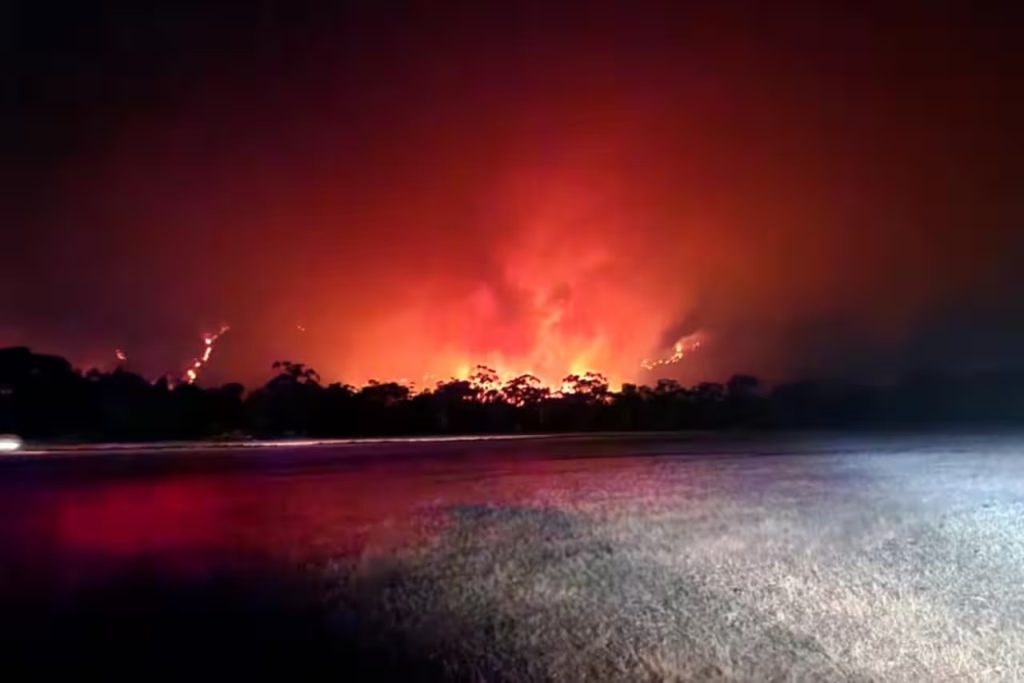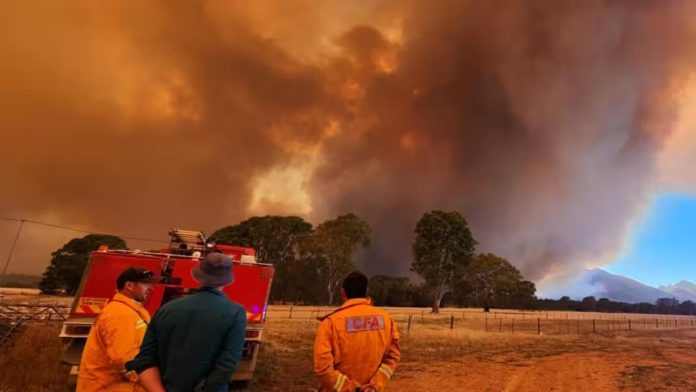By Dr.Majid Khan (Melbourne)
Australia is experiencing a heightened risk of bushfires, especially in its southeast, where intense heat waves have pushed temperatures up to 14°C (25.2°F) above average. In particular, the state of Victoria has been facing severe conditions, with fire bans issued for large parts of the region. The situation is further complicated by the aftermath of a devastating fire in Grampians National Park, which had already ravaged homes and farmland. These early signs of an intense bushfire season point to an escalating crisis as Australia grapples with increasingly frequent and severe fires.
The danger of bushfires in Australia is not new, as the country has long been prone to wildfires. However, recent data from the Bureau of Meteorology (BOM) indicates that the risks are becoming more extreme. In 2024, Australia experienced its second hottest year on record since 1910, with temperatures averaging 1.46°C above normal. This, combined with prolonged heatwaves and periods of drought, has created tinderbox conditions, making wildfires more frequent and intense. Additionally, experts warn that the heatwaves will continue to increase in severity as climate change accelerates, with some areas like Sydney potentially reaching temperatures of up to 50°C in the coming decades.
The devastating fires of the 2019-2020 “Black Summer” were a wake-up call for Australia, as record-breaking heat combined with dry conditions led to fires that ravaged large areas of the country. The Black Summer is still a nightmare for many Australians especially those who suffered. Danny J, 59, running an automotive business in Tumbarumba NSW, one of the regions which were badly affected by the 2019-2020, Black Summer, said around 20 cars were burnt including other of his property lost in those horrific days.
Since then, fire seasons have seemed quieter, but the underlying risks have not diminished. The lack of proper preparation, exacerbated by climate change, means that Australia remains vulnerable to catastrophic bushfires that can spread rapidly through dry forests, damaging homes, wildlife, and farmland.
One of the central challenges in addressing these fires is the degradation of the infrastructure and resources needed to manage them. Networks in regional Victoria, for example, are reaching the end of their lifespan and displaying numerous problems. Although manual inspections are conducted every few years, they aren’t frequent enough to address potential hazards.

Moreover, as temperatures rise, the fire season starts earlier and lasts longer. Changes in temperature, humidity, and rainfall patterns during spring and early summer further complicate fire management efforts. The opportunities for prescribed burning—controlled fires that reduce fuel and mitigate larger wildfires—are becoming increasingly limited. Even if fire seasons aren’t as severe as the “Black Summer,” the long-term trend of hotter, drier conditions means that these fires will become more frequent and uncontrollable.
While climate change is not the direct cause of bushfires, it certainly makes them worse. The warming planet is driving more frequent and intense heatwaves, prolonged dry spells, and droughts, all of which increase the chances of wildfires starting and spreading. In the lead-up to the 2019-2020 fires, Australia saw record-breaking temperatures across the continent throughout December. The latest statistics show that 2024’s temperatures were 1.46°C above the average. This increase in extreme temperatures, combined with the effects of climate change, has created conditions where wildfires are more likely to grow into uncontrollable infernos.
Climate change also exacerbates the limitations faced by firefighting resources. Australia’s ability to prepare for and manage fires is hampered by an overreliance on a volunteer-based firefighting force and limited access to firefighting aircraft. During large-scale fires, Australia has often had to rely on water-bombing aircraft from overseas, as domestic resources are insufficient to combat the scale of these blazes. Additionally, the windows of safe weather for conducting hazard reduction burns—controlled fires set in cooler weather to reduce fuel—are becoming shorter and harder to predict. This further complicates efforts to prevent the spread of wildfires and protect communities.
The severity of the situation is not unique to Australia. According to a UN report, extreme wildfires are expected to increase globally, with an estimated 50% rise in the frequency of such fires by the end of this century. Researchers predict that rising temperatures, changes in land use, and prolonged droughts will continue to drive this increase, leading to more frequent and intense fires. UN report stresses the need for a radical reallocation of financial resources, prioritizing prevention over firefighting, to address the growing threat of extreme wildfires.
Australia, as one of the countries most affected by the effects of climate change, is already witnessing an increase in the number of extremely hot days. This, in turn, is driving the escalation of bushfire conditions. The Climate Council warns that a warming planet is creating more dangerous bushfire conditions, increasing the risks to both people and property. In addition to the physical damage caused by these fires, there is a significant impact on Indigenous species, some of which are dying in large numbers due to the fire’s extreme heat and intensity.
The unprecedented scale and intensity of the 2019-2020 fires served as a global reminder of how climate change is driving catastrophic weather events. These fires, in terms of their extent, timing, and intensity, highlighted the already visible impacts of a warming planet. However, the lesson learned from this disaster is not just about the damage that wildfires cause; it is also about how human settlements have increasingly been placed in harm’s way. Over the past 50 years, there has been a movement towards rural and coastal areas, often in regions surrounded by forested land, a phenomenon known as ‘sea change’ or ‘tree change.’ This development pattern has led to homes being constructed in fire-prone areas, further increasing the vulnerability of these communities.
There is an urgent need for an effective and scientifically informed response to the ongoing bushfire crisis. This response must build on the lessons learned from past disasters. Unfortunately, these lessons are often forgotten over time, as major fires are infrequent, leading to a false sense of security.
Two critical sources of knowledge must be integrated into current fire management strategies: the testimony of survivors and the hard statistics of destruction. Survivor accounts reveal how extreme stress can disrupt rational decision-making, making it difficult for people to act effectively in the face of danger. Understanding the psychological impact of stress on decision-making can help refine warnings and advice during fire emergencies. Additionally, the collective statistics of destruction provide a grim reminder that similar fires have happened before and will continue to happen unless systemic changes are made.
While focusing on climate change is vital, it should not overshadow the need to learn from the past. Addressing the challenges posed by bushfires requires a comprehensive approach that combines scientific knowledge with psychological insights and historical lessons.
A rational and effective response to the bushfire crisis cannot be achieved without acknowledging the broader social, economic, and environmental factors that contribute to the problem. The capitalist profit system, which prioritizes corporate interests over public safety, is a root cause of environmental destruction. Only by reorganizing society to prioritize social needs can resources be mobilized to address the growing threat of extreme weather events.






